 Research Article
Research Article
EffiSpray: Development of an Innovative Decision Support System for Increasing Spraying Application Efficiency
Zisis Tsiropoulos*, Michail D. Kaminiaris, Michael Voskakis, Evangelos Skoubris, Aliki Tsiropoulou and Aikaterini-Maria Michailidou
Agricultural and Environmental Solutions (AGENSO), Markou Mpotsari 47, Athens, 11742, Greece
Zisis Tsiropoulos, Agricultural and Environmental Solutions (AGENSO), Markou Mpotsari 47, Athens, 11742, Greece. Email: tsiropoulos@agenso.gr
Received Date: September 07, 2022; Published Date: September 22, 2022
Abstract
How could modern agriculture become more sustainable? A major and integral part of intensive farming is spraying application. However, sprayings may significantly jeopardize environmental and human safety if not applied under optimal meteorological parameters. EffiSpray application, available in https://www.effispray.com, comes to indicate the appropriateness of environmental circumstances for achieving an effective spraying application, by considering ambient temperature, precipitation, relative humidity, and wind speed for suggesting the suitability for spraying application for the following 5 days. Results are presented in a colored interactive map, structured in a four-layered model consisting of different levels (green for optimal spraying conditions, yellow for acceptable spraying conditions, orange for emergency spraying only, and red for spraying avoidance). Thus, interested end-users such as farmers, agronomists, advisors, and stakeholders involved in the agricultural production can freely access EffiSpray either online via the web tool, or by downloading the smartphone application available in Google Play without any financial charges. EffiSpray has been developed aiming to solemnly operate as a valuable tool in the hands of its users for increasing sustainability and efficiency of agricultural practices exercised.
Keywords: Spraying application; Precision agriculture; Smart agriculture; Decision support; DSS; Environmental parameters; Interactive map; Environmental impact; Human health
Graphical Abstract
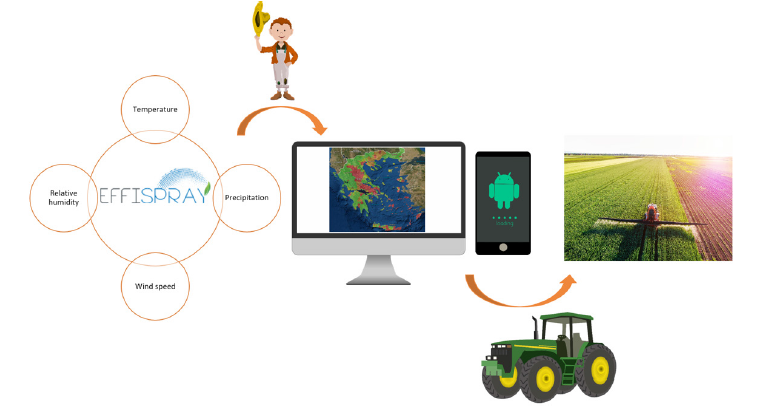
Introduction
During the 1940s, chemical industry started to exploit synthetic chemistry in order to develop and further commercialize chemical pesticide products. However, it was not until the 1960s that the agricultural sector, was supported by the wide use of such pesticides. Different categories of the aforementioned pesticides have been developed, such as fungicides, insecticides, herbicides, nematicides etc. and introduced into the market. As crop yield losses can reach up to over 70% of the total production in several cropping systems and countries [1], crop protection has been identified as a one-way road for the mitigation of diseases’ outbreaks and pests’ infestation.
Nevertheless, the consequent constant expansion and growth of the global economy, has led to a significant increase of the agricultural and industrial sectors. Thus, an extensive utilization and application of Plant Protection Products (PPPs) has been performed during the second half of the 21st century [2]. The effect of this irrational use of synthetic pesticides can be observed in the results retrieved by the Rapid Alert System for Food and Feed (RASFF) annual report for 2020 [3]. More specifically, during 2020, a total number of 667 notifications for pesticide residues was monitored, indicating the severity of the aspect, with multiple results on human, animal and environmental health. The constantly increasing occurrence of pesticides’ residues in agricultural goods over the last 10 years has put them in the list with the most hazardous contaminants occurring in serious border rejections in EU trade [4].
In this context, EU has put in force a regulatory framework for the use of Plant Protection Products (Regulation (EC) No 1107/2009), while maximum legal limits are set for the occurrence of the various pesticides in the agricultural products, as described by the Regulation (EC) No 396/2005, expressed as maximum residue levels (MRLs). Furthermore, Directive 2009/128/EC of the European Parliament establishes a community framework for achieving sustainable use of pesticides by addressing the migration of pesticides in the food production chain and mitigating the risks and effects of pesticide use on human health, that result from the unreasonable use of pesticides.
In order to confront the aforementioned problem in practice, serious effort has been performed for the optimization of spraying application. Major research has been conducted in the development of Decision Support Systems for variable rate application aiming to achieve a more effective and economical treatment of plant diseases. This way, productivity can be improved, while simultaneous reduction of the environmental impact is possible. As a result, competitiveness of the producers and the agricultural goods produced is achieved by introduction into precision agriculture and farming.
Such attempts have allowed the introduction of a Decision Support System for optimizing spraying applications in vineyards [5], a Decision Support system for precise pest management of the Mediterranean fruit fly [6], a Decision Support System for the variable rate fertilizing applications in soybean [7], a Decision Support System for fungicide applications against Colletotrichum acutatum fungus in citrus cultivations [8], and various other DSSs. Additionally, there is literature supporting the significant reduction of pesticides used under the exploitation of novel Decision Support Systems for spraying optimization [9].
As the ambitious goal set by the EU Green Deal and Farm to Fork strategies, regarding a 50% reduction in the use of pesticides by 2030 is a major target for the European agricultural industry, numerous attempts are constantly being performed for controlling the use of pesticides. Within this framework, critical outputs highlight customized Decision Support Systems for specific plant-pathogen complexes, providing users with the ability to manage certain pests or pathogens. However, there is limited research output on the environmental suitability of the various environmental parameters for spraying applications.
EffiSpray comes to address this lack, by introducing a cuttingedge tool that empowers all interested users operating in the agricultural sector with a way to easily and freely scout the appropriateness and suitability of the current and 5 upcoming days for spraying application based on ambient temperature, precipitation, relative humidity, and wind speed.
Methods
Technical implementation
The idea of EffiSpray first occurred in Greece. Consequently, a total of 1246 meteorological stations from diverse open-access sources was used in order to obtain air temperature, air humidity, relative humidity, and wind speed data for the entire country, which were used for further calculation of 4 different risk levels regarding suitability of spraying conditions. In microclimatic level, it is clear that regions characterized by differentiating versatile weather conditions, may need customized treatment regarding spraying application. In this context, precision agriculture solutions are able to support decision making on behalf of the interested user.
Regarding EffiSpray map development, a fragmented map of the country was used together with the geolocation of the open access meteorological stations in order to achieve the division of the country in regions that contain at least one meteorological station. This segmentation allowed drawing the map with a sufficient number of polygons that can differentiate in coloring for the graphical representation of the various areas. The complex algorithm of EffiSpray is based on equations taking into consideration 4 environmental parameters.
Environmental parameters
Several weather conditions such as wind, temperature, relative humidity and precipitation significantly influence the effectiveness of spraying applications and the potential waste of the solution by run-off and spray drift. Furthermore, a computer program for estimating pesticide spray efficiency has been introduced in order to avoid drift of air-assisted conventional applications [10]. In order to achieve the optimum result, the aforementioned environmental parameters were taken into consideration.
It is also worth mentioning that not only environmental parameters affect spraying efficiency. For instance, application volume rate, airflow rate and target position also affect the outcome of spraying application [11]. In addition to that, nozzle type, and distance from target are proven to be highly significant for an effective spraying application [12].
However, in the current study, the environmental parameters affecting spraying application efficiency were considered for creating EffiSpray Decision Support System and are presented below together with their role in the final outcome. Thus, the reason behind their selection is explained in detail.
Ambient temperature: Air temperature significantly affects the efficiency of plant protection substances used for agricultural spraying application. It is widely acceptable that the higher the temperature is, and the lower the humidity is, the faster evaporation occurs from the target sprayed. As a result, the deposition of smaller droplets may be reduced, and the risk of air drift may be increased. Furthermore, early morning fog is a result of temperature inversion and spraying is prohibited under this condition. In addition to this, sunlight and temperature can also affect the flight periods of beneficial insects such as bees and various other pollinators.
The optimum application temperature for each plant protection substance is indicated on the label of the formulated commercial product, which the farmer should consult for recommendations prior to spaying application. However, there are several aspects that are generally accepted. More specifically, spraying should be performed when temperatures are low and relative humidity is high. This reduces the chance of air drift due to temperature inversion or evaporation and increases the chance of deposition on the target. Conditions are often best in the early morning hours after cloud cover, but spraying should be performed in the evening/night if there is a chance of disrupting bee activity. Normally, spraying is not performed when temperature exceeds 25 °C.
For the aforementioned reasons, ambient temperature was selected as a crucial parameter affecting spraying efficiency and was consequently exploited in the development of EffiSpray.
Precipitation: Precipitation may have positive or negative effects on spraying application. Some products work better when rain carries them into the soil after application, but not far enough, allowing them to enter the water available to plants. Depending on the resistance of the plant protection substance to rain, rain immediately after application can also wash the product off the leaves and reduce the level of protection provided. Finally, rain can also carry some amount away from the target and reduce the efficiency of spraying application.
Farmers should monitor weather forecasts and understand the effects of the pesticide that are going to be applied. Spraying should be avoided when foliage is still wet from rain or dew, unless suggested by the product label. A leaf can only hold a limited/ specific spray volume and therefore a limited amount of chemical product. Once wet, the spray liquid that has not been absorbed by the leaf will not be retained and the excess will be transferred to the lower leaves and subsequently to the soil.
For the aforementioned reasons, precipitation was selected as a crucial parameter affecting spraying efficiency and was consequently exploited in the development of EffiSpray.
Relative humidity: As already mentioned, relative humidity of the ambient air affects the efficiency of spraying application. In general, spraying application should be performed when relative humidity is less than 40%. However, relative humidity standalone is not a highly restricting parameter. Nevertheless, when taken into consideration together with temperature, elaborate patterns can derive regarding the suitability of the meteorological conditions for spray application. Temperature and relative humidity interactions can significantly influence the occurring conditions and thus differentiate the appropriateness for spraying application.
For the aforementioned reasons, relative humidity was also selected as a crucial parameter affecting spraying efficiency and was consequently exploited in the development of EffiSpray.
Wind speed: Air drift of the spray cloud is the amount of crop protection product that is applied outside the spraying area due to the action of air occurring during spraying. Wind speed and direction during spraying are always factors to consider, because high wind speed and incorrect wind direction can create spray drift. Spray application under inappropriate conditions due to wind can reduce spray coverage, particularly at specific crop phenological stages. Coverage is improved and drift is reduced when spraying is performed in calm air conditions which usually occur at night or early morning.
The drift of the spray cloud due to the wind is one of the main reasons for reduced spraying efficiency, resulting in losses of plant protection products and insufficient plant protection, apart from environmental pollution. This can also damage neighboring crops. In order to avoid air drift, the ideal spray time is when the Beaufort scale force is 2 (light breeze), which is translated to wind speed variating between 3.2 and 6.5 km/h (0.9-1.8 m/s).
Poor wind (below 3.2 km/h) can leave droplets suspended in the air, prone to evaporation and potential drift to unintended targeting long after spraying. High speed wind or variable direction wind can carry droplets away from target. Furthermore, depending on the crop leaf index, wind speed is usually highest at the field borders, such as in the outer rows and tops of the crop, which should be taken into account for achieving an efficient spray application.
For the aforementioned reasons, wind speed was also selected as a crucial parameter affecting spraying efficiency and was consequently exploited in the development of EffiSpray.
Results
The EffiSpray Decision Support System is freely accessible in https://www.effispray.com for all possible interested users, while the mobile application is also available in Google play in https://play. google.com/store/apps/details?id=gr.agenso.effispray&hl=en_IE. Both tool versions are described in detail below.
EffiSpray web tool
Upon accessing the EffiSpray web tool, user is initially provided with a brief description about the aim of the tool (Figure 1) indicating the functionality of the EffiSpray interactive colored map.
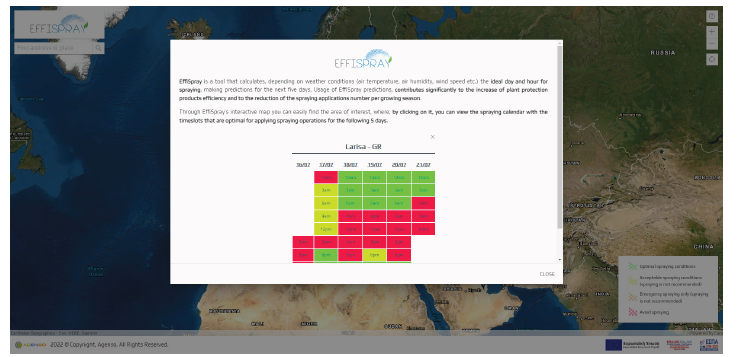
After selecting “Close” button, user is provided with an indication regarding the process and the selection of a specific area (Figure 2).
After selecting “OK!” button, user has the ability to use the zoom in, zoom out, and find location buttons which are displayed on top right area of the web page (Figure 3).

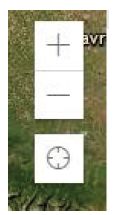
In addition to that, on the bottom right area of the web page, users are presented with the 4 possible different levels of spraying suitability (Figure 4).
Furthermore, on the top left area of the web page, a search bar is accessible, where user can type a specific place/area/region/ address for further quest after using the search button (magnifying glass symbol) (Figure 5).
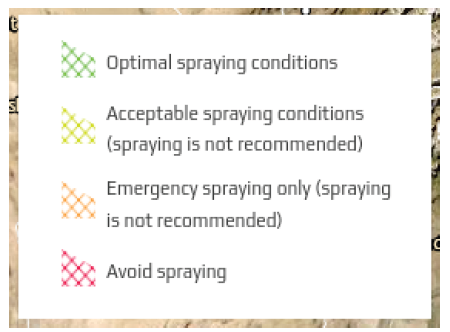
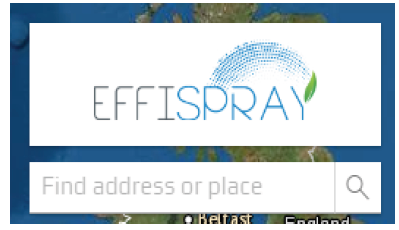
Upon clicking on any part of the worldwide interactive map, user is presented with a table (Figure 6), containing a prediction of the 5 upcoming days for the selected area, where predictions are displayed in different coloring based on the aforementioned 5-level scale, with an escalation step of 3 hours.
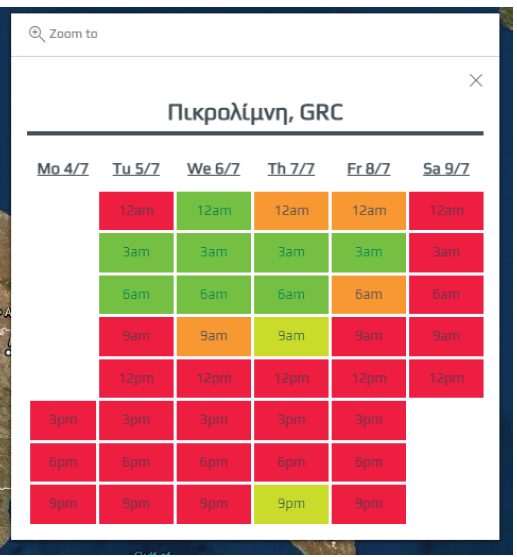
It is also worth mentioning that in the Greek version of the tool (https://www.effispray.com/el), map of Greece is directly presented with the colored display result of the current situation (Figure 7) based on the various present meteorological data.
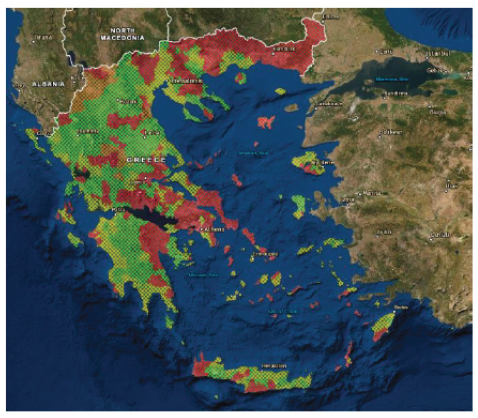
In addition to that, in the Greek version, it is also possible to perform the projection of a specific daytime result for a specific area, by simply dragging the timeline slider or by pressing the right and left arrows (Figure 8). The slider is placed on the bottom left area of the web page of the Greek version of the tool.

In both the Greek and English versions of the tool, user has the identical ability to select a specific area from the worldwide map by clicking on it and obtain the subsequent information. As of July 2022, the EffiSpray tool is also available in an Italian version (Figure 9) and a Brazilian version (Figure 10), https://www.effispray.com/it and https://www.effispray.com/br respectively.
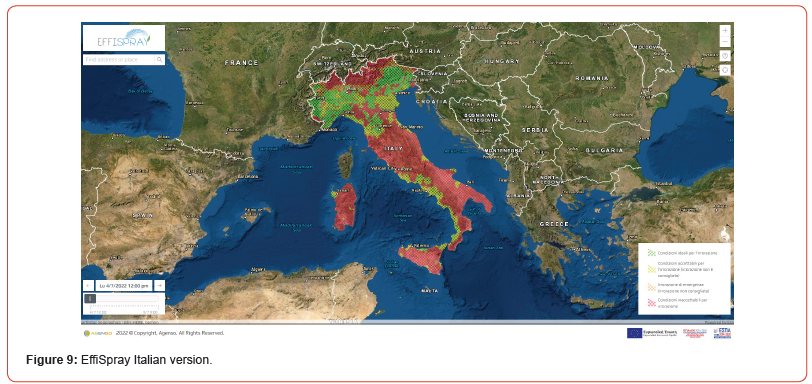
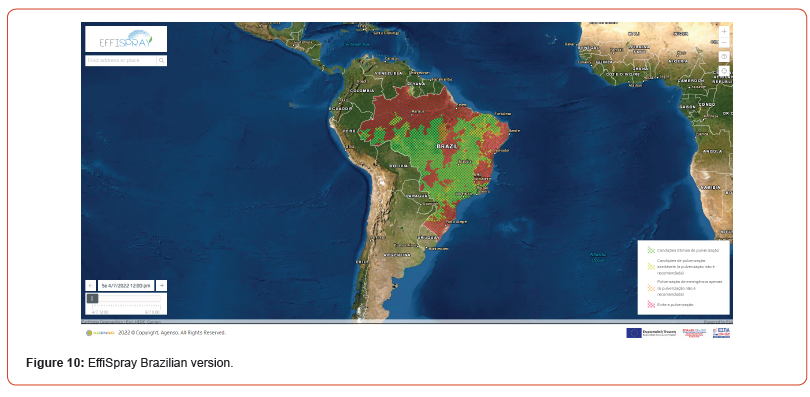
The integrated development approach of the tool, offers a Decision Support System fully functional in both languages (IT and BR) apart from English, which facilitates a broader acceptance and engagement of local end-users.
EffiSpray Android application
The responsive process followed during the EffiSpray development, allows access to the Decision Support System by a variety of devices. Thus, EffiSpray is also available in Google Play, with more than 500 downloads as of July 2022 (Figure 11).
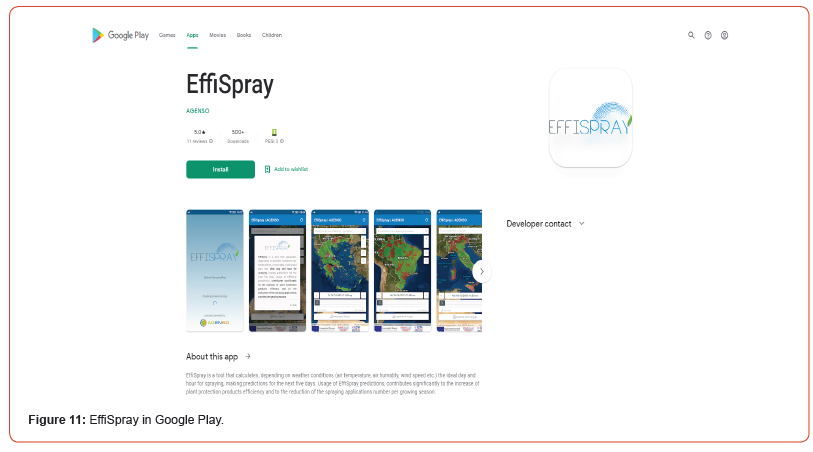
This way, user is able to freely and without additional charges download EffiSpray Decision Support System, and access the predictions provided from portable devices (Figure 12). The ultimate aim is to facilitate decision making process regarding spraying application, from any possible location, meaning both in stationary facilities, and in farm/agricultural production unit adhoc.
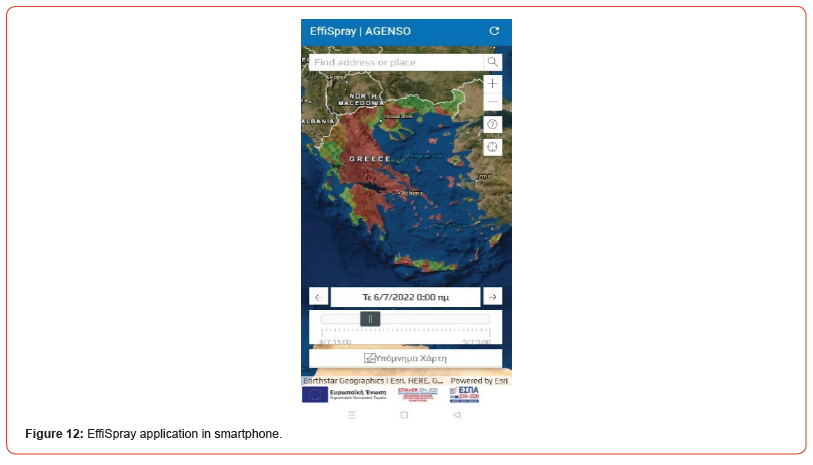
The aforementioned functionalities of the tool, as described in web tool description paragraph, are respectively available in the application version.
Discussion
When planning the various pesticide spray applications, millions of farmers worldwide are compelled to take into account local meteorological forecasts, sometimes from diverse open access sources, as well as from paid platforms and subscription services. This action requires a significant amount of time to be devoted to decision making process prior to exercising the agricultural practice. However, this valuable time could be spent in other aspects of the production chain process, allowing fast track actions that boost the competitiveness of the final agricultural goods produced. Additionally, the error possibility is increased when the need to combine several distinct heterogeneous data arises. As a result, farmers should decide by themselves, usually with sometimes limited assistance by local extension and advisory services, whether the environmental conditions are favorable for spraying their cultivations or not.
EffiSpray, developed by AGENSO, comes to cover this existing market gap in the sector of highly accurate decision support tools open to all users, for increased efficiency of spraying applications. Since the launch of the tool, and as of July 2022, around 18,000 users have visited the EffiSpray web tool, which counts almost 50,000-page views with an average session duration of around 1: 30 (minutes: seconds).
As the parameters that affect spray drift have been widely assessed during the last decades, and especially in the past years [13,14], an ISO standard, ISO 22866:2005 [15], is active for establishing the principles for the measurement of droplet drift by all agricultural equipment destined to apply plant protection production. The aim of the standard is to produce a sustainable framework, under which all interested users will be able to apply and adopt imperishable and homogeneous practices for setting transparent and steady action plans, while simultaneously reducing any possible negative impact on human health and environment [16].
In this context, biodiversity conservation, improving of water quality together with reducing water scarcity, and ecosystems’ enhancement are key players in increasing climate change mitigation and resilience, apart from crop health maintenance. The significance of the aforementioned key players can be reflected in the need for sustainable agricultural production and in the need for maximizing the profit of the farmers in order to increase the potential for further modernization of the agricultural sector.
Moreover, a wealth of pesticide monitoring/detection methods and techniques has been introduced during the last years for both in field and in laboratory analysis [17-19]. Furthermore, the wide exploitation of decision support systems for enhancing agricultural productivity through holistic farm management [20] has led to adoption of precision agriculture management systems by farms of diverse size, ranging from small to big farms [21], with special further expansion in the livestock production sector [22].
Based on the current necessities and trends in EU level, as well as in global level, it is a strong belief of the authors, that in the near future, spray applications of plant protection products will inevitably be accompanied by the use of smart innovative systems/ tools and applications. The aforementioned tools and applications will be able to guide users for ensuring right application of chemical inflows in the food production chain for accomplishing sustainability and concurrent increase of yield. Therefore, the need for the development of such tools will thereby progressively grow in that regard.
In this perspective, EffiSpray is created aiming to act as a useful, easy to use tool by farmers and relevant operators seeking for spraying application optimization and efficiency improvement. The ultimate purpose of EffiSpray is the reduction of irrational and inefficient use of pesticides that may pollute the environment, jeopardize human health and safety, as well as safety of non-target organisms, lead to the development of pesticide resistance, and shrink the farmers’ income via the need for repetitive applications.
Acknowledgement
The EffiSpray Decision Support System has been developed in the framework of EffiSpray project, which was funded through the Greek National ESPA EPAnEk 2014-2020 (Co-funded by the European Union), under the operational program “Competitiveness, Entrepreneurship, Innovation”. Project title: “EffiSpray: An innovative system for EFFiciency optimization of Spraying operations”, Grant agreement no. T1ΕΔΚ-05249.
Conflict of Interest
No conflict of interest.
References
- Gharde Y, Singh PK, Dubey RP, Gupta PK (2018) Assessment of yield and economic losses in agriculture due to weeds in India. Crop Prot 107: 12-18.
- Sharma A, Kumar V, Shahzad B, Tanveer M, Singh Sidhu GP, et al. (2019) Worldwide pesticide usage and its impacts on ecosystem. SN Appl Sci 1: 1446.
- (2020) The Rapid Alert System for Food and Feed.
- Papapanagiotou EP (2021) Serious alert and border rejection notifications on food in the EU RASFF. Vet Sci 8(11): 279.
- Gil E, Escolà A (2009) Design of a decision support method to determine volume rate for vineyard spraying. Applied Eng in Agric 25(2): 145–151.
- Sciarretta A, Tabilio MR, Amore A, Colacci M, Miranda MÁ, et al. (2019) Defining and evaluating a decision support system (DSS) for the precise pest management of the Mediterranean fruit fly, Ceratitis capitata, at the farm level. Agronomy 9: 608.
- Nugraheni PHT, Mawardi M, Sutiarso L, Nugroho AP, Virgawati S, et al. (2019) Development of a decision support system for mapping variable rate fertilizing application on Soybean (Glycine max) cultivation. IOP Conf. Series: Earth and Env Sc 355: 012008.
- Gama AB, Silva Junior GJ, Peres NA, Molina J, Maluf de Lima LM, et al. (2019) A threshold-based decision-support system for fungicide applications provides cost-effective control of citrus postbloom fruit drop. Plant Dis 103: 9.
- Lázaro E, Makowski D, Vicent A (2021) Decision support systems halve fungicide use compared to calendar-based strategies without increasing disease risk. Commun. Earth Environ 2: 224.
- Hong SW, Zhao L, Zhu H (2018) SAAS, a computer program for estimating pesticide spray efficiency and drift of air-assisted pesticide applications. Comp and Electr in Agri 155: 58-68.
- Musiu EM, Qi L, Wu Y (2019) Spray deposition and distribution on the targets and losses to the ground as affected by application volume rate, airflow rate and target position. Crop Prot 116: 170-180.
- Grella M, Gallart M, Marucco P, Balsari P, Gil E (2017) Ground deposition and airborne spray drift assessment in vineyard and orchard: the influence of environmental variables and sprayer settings. Sustainability 9(5): 728.
- Baio FHR, Antuniassi UR, Castilho BR, Teodoro PE, Silva E Ed (2019) Factors affecting aerial spray drift in the Brazilian Cerrado. PLOS ONE 14(6): e0217957.
- Chen S, Lan Y, Zhou Z, Ouyang F, Wang G, et al. (2020) Effect of droplet size parameters on droplet deposition and drift of aerial spraying by using plant protection UAV. Agronomy 10: 195.
- (2005) International Organization for Standardization.
- Tudi M, Daniel Ruan H, Wang L, Lyu J, Sadler R, et al. (2021) Agriculture development, pesticide application and its impact on the environment. Int J Environ Res Public Health 18(3): 1112.
- Skotadis E, Kanaris A, Aslanidis E, Michalis P, Kalatzis N, et al. (2020) A sensing approach for automated and real-time pesticide detection in the scope of smart-farming. Comp and Electr in Agri 178: 105759.
- Ouse DG, Gifford JM, Schleier J, Simpson DD, Tank HH, et al. (2018) A new approach to quantify herbicide volatility. Weed tech 32(6): 691-697.
- Zhao F, He J, Li X, Bai Y, Ying Y, et al. (2020) Smart plant-wearable biosensor for in-situ pesticide analysis, Biosensors and Bioelectronics 170: 112636.
- Ara I, Turner L, Harrison MT, Monjardino M, DeVoil P, et al. (2021) Application, adoption and opportunities for improving decision support systems in irrigated agriculture: A review Agric Water Manag 257: 107161.
- Loures L, Chamizo A, Ferreira P, Loures A, Castanho R, et al. (2020) Assessing the effectiveness of precision agriculture management systems in Mediterranean small farms. Sustainability 12(9): 3765.
- Kassahun A, Bloo R, Catal C, Mishra A (2022) Dairy farm management information systems. Electronics 11(2): 239.
-
Zisis Tsiropoulos*, Michail D. Kaminiaris, Michael Voskakis, Evangelos Skoubris, Aliki Tsiropoulou and Aikaterini-Maria Michailidou. EffiSpray: Development of an Innovative Decision Support System for Increasing Spraying Application Efficiency. World J Agri & Soil Sci. 8(3): 2022. WJASS.MS.ID.000686.
-
Spraying application, Precision agriculture, Smart agriculture, Decision support, DSS, Environmental parameters, Interactive map, Environmental impact, Human health
-

This work is licensed under a Creative Commons Attribution-NonCommercial 4.0 International License.






